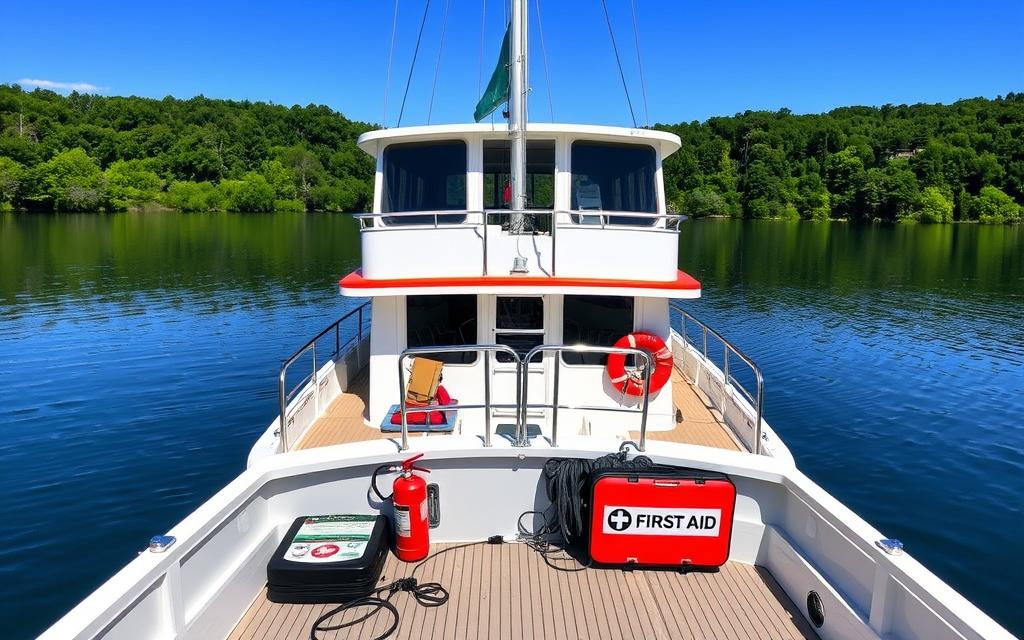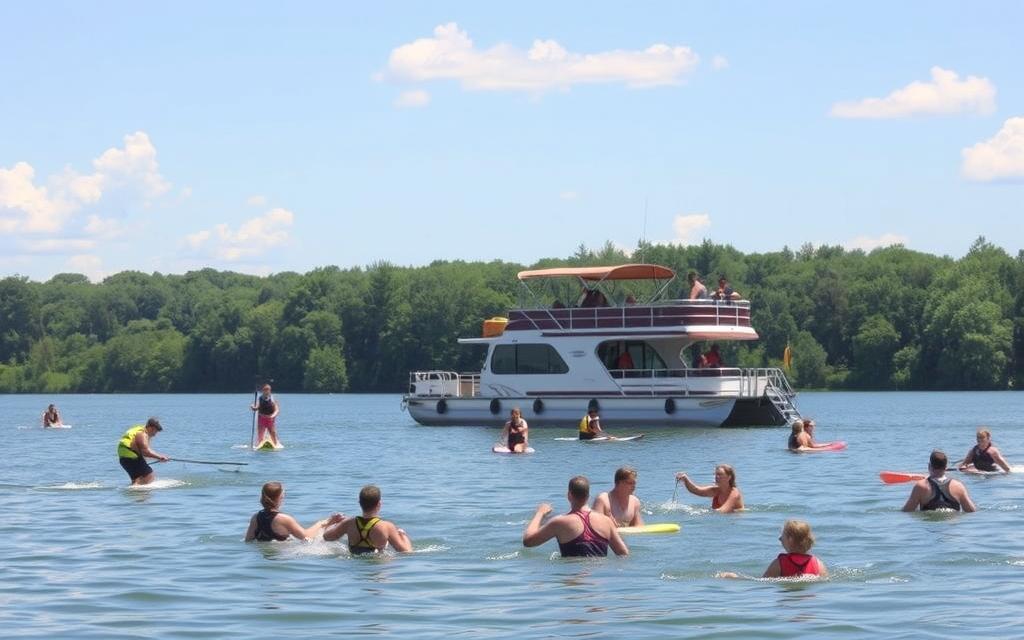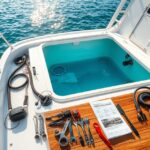Table of Contents
Ever thought about what makes a boating trip great or dangerous? Marine safety is more than just gear. It’s about knowing, preparing, and thinking ahead.
I’ve spent years teaching houseboat lovers how to stay safe on the water. This guide will change how you see boat safety and emergency plans.
Knowing the rules and safety steps is key for safe boating. This guide is for everyone, whether you’re a pro or just out for fun. It will teach you how to keep yourself and others safe.
Key Takeaways
- Master complete marine safety techniques
- Understand key emergency preparedness strategies
- Learn vital boat navigation skills
- Spot possible maritime dangers
- Build proactive safety management plans
Essential Safety Equipment for Your Houseboat
Having the right gear is key to staying safe on the water. Houseboat trips can be amazing, but you need to be ready for anything. This includes avoiding dangers like electrical issues and being prepared for emergencies.
Required Life-Saving Devices and Storage
Life jackets are the most important safety item for any boat. Make sure you have enough for everyone on board. Here are some tips for storing them:
- Keep life jackets in clear, visible areas
- Ensure they are not blocked by other equipment
- Check for proper sizing and condition annually
Fire Prevention and Emergency Equipment
Fire safety is vital on houseboats. Having fire extinguishers in the right spots can save lives. Here’s where to put them:
| Location | Recommended Equipment |
|---|---|
| Kitchen Area | Class K Fire Extinguisher |
| Engine Room | Class B Fire Extinguisher |
| Electrical Panels | Class C Fire Extinguisher |
Navigation Lights and Sound Signals
Good navigation gear helps avoid accidents and keeps you seen at night. Weather alerts and communication tools are also key for safe travel.
“Safety on the water is not an accident, but a preparation.” – Maritime Safety Expert
Don’t forget about carbon monoxide safety. Make sure detectors work and there’s enough air. Always keep your safety in mind by checking and knowing your emergency equipment.
Understanding Marine Weather and Navigation
Navigating a houseboat is more than just steering. It’s about knowing the marine weather and how to navigate. Water weather can shift quickly, so being ready is key for safety.
- Reading nautical charts accurately
- Interpreting marine weather forecasts
- Understanding GPS and navigation tools
- Recognizing storm indicators
“Knowledge of marine conditions is your best defense against unexpected challenges on the water.” – US Coast Guard Safety Guidelines
Before you set off, check the weather. Use different sources for weather info, like services made for the sea. Look for wind, wave height, and storm warnings that might affect your safety plans.
Navigation tools are vital for keeping your houseboat safe. Modern GPS, radar, and electronic charts give you updates on your area. Knowing buoy markers and nautical signs helps avoid dangers.
Boating laws mean you must always be aware of your surroundings. This includes watching out, knowing who has the right of way, and being ready to change course if needed.
Key Navigation Skills
- Learn to read marine charts
- Understand weather pattern indicators
- Practice using GPS and navigation tools
- Know local boating regulations
Mastering these skills boosts your confidence and safety on the water. It makes your houseboat trips more fun and safe.
Comprehensive Houseboat Safety Guide: Pre-Departure Checklist
Getting ready for a houseboat trip needs careful planning and a good check-up. A detailed checklist before you leave can make your trip smooth or help avoid problems. I’ll show you how to prepare for a safe journey before you sail.
Hull and Engine Inspection Points
First, check your houseboat’s hull and engine before you go. Look for any damage or wear that could be dangerous on the water.
- Check hull for cracks or structural damage
- Examine engine mounting and fluid levels
- Verify propulsion system functionality
- Inspect electrical connections
Safety Equipment Verification
Safety gear is vital in emergencies. Make sure all important safety items are in good shape, like fire extinguishers, life jackets, and emergency radios.
- Confirm fire extinguishers are fully charged
- Check expiration dates on safety equipment
- Ensure life jackets are appropriate for all passengers
- Test emergency communication devices
Weather and Route Planning
Good weather checks and route planning are key to safe travel. Use weather forecasts and navigation rules to plan a safe path.
“Preparation is the key to safe maritime travel” – Coast Guard Safety Manual
When planning your route, remember these important points:
- Review detailed weather forecasts
- Understand local navigation rules
- Plan docking procedures in advance
- Practice anchoring techniques
By using this detailed checklist, you can greatly lower risks and make your houseboat trip safer and more fun.
Carbon Monoxide Safety: Silent Danger Prevention
Carbon monoxide is a silent killer on houseboats that many boaters ignore. It’s invisible and has no smell, making it deadly in closed spaces. Knowing about carbon monoxide detectors and where to put them is key to staying safe on the water.
“Prevention is always better than cure when it comes to carbon monoxide exposure on watercraft.” – Marine Safety Expert
Houseboats can have many sources of carbon monoxide, including:
- Gasoline-powered generators
- Onboard cooking appliances
- Heating systems
- Engines and exhaust systems
- Nearby boat exhausts during marina stays
To stay safe, you need to take several steps. Install carbon monoxide detectors all over your houseboat, but focus on areas where people sleep and near engines. Make sure to check these detectors often and change the batteries every year to keep your boat electrically safe.
| Detector Location | Recommended Placement |
|---|---|
| Main Living Area | Central ceiling mounting |
| Sleeping Quarters | Within 10 feet of bedroom doors |
| Engine Compartment | Near possible emission sources |
Signs of carbon monoxide poisoning include feeling dizzy, having headaches, feeling weak, and nausea. If you think you’ve been exposed, get out to fresh air right away and see a doctor. Keeping your boat well-ventilated, maintaining fuel-burning equipment, and using navigation lights and emergency supplies can help lower your risk.
Electrical System Safety and Maintenance
Houseboats need careful electrical system checks for safety and reliability. Knowing how to manage electrical systems can avoid dangers. It keeps your boat and crew safe while on the water.
Keeping electrical systems in good shape is key for boating safety. Every houseboat owner should know these important steps.
Shore Power Connection Guidelines
Connecting to marina power requires following some important rules:
- Check shore power cords for damage before use
- Use only marine-grade electrical connections
- Make sure electrical systems are properly grounded
- Verify the voltage matches your houseboat’s needs
Battery Management and Monitoring
Good battery care is vital for power on the water:
- Regularly check battery charge levels
- Clean battery terminals to avoid corrosion
- Use a multimeter to check battery health
- Replace batteries every 3-5 years
Common Electrical Hazards to Avoid
Watch out for these signs of electrical danger:
- Water near electrical parts
- Overloaded circuits
- Frayed or damaged wiring
- Improper electrical setups
“A well-maintained electrical system is your first line of defense against marine emergencies.” – Marine Safety Expert
Following these guidelines can greatly lower the risk of electrical problems. This ensures a safer boating experience.
Safe Anchoring and Docking Procedures
Learning how to dock and anchor safely is key for houseboat travel. Knowing the rules of the waterways and using the right techniques can avoid dangers on the water.

Getting ready to dock is important. I suggest a step-by-step plan to keep your houseboat safe in different water conditions. Pay attention to wind, current, and space when docking.
- Check wind and current conditions before approaching
- Prepare dock lines and fenders in advance
- Approach the dock slowly and at a controlled angle
- Use spring lines to stabilize your houseboat
Anchoring also needs careful attention. Make sure your houseboat checklist includes the right anchor for each water type.
| Anchor Type | Best Used In | Holding Power |
|---|---|---|
| Danforth | Sandy or Muddy Bottoms | High |
| Plow | Mixed Bottom Conditions | Medium-High |
| Mushroom | Soft Mud | Low-Medium |
“Proper anchoring is not just about equipment, but understanding your environment.” – Coast Guard Safety Manual
Being aware of water hazards is vital for safe anchoring. Always check water depth, look out for underwater dangers, and watch for other boats before anchoring. Regularly check your anchoring gear for wear and damage, as suggested by houseboat maintenance tips.
By practicing these steps, you’ll become a confident and safe houseboat user. Smooth docking and secure anchoring will make your boating trips better.
Emergency Preparedness and Response Plans
Being ready for emergencies on a houseboat is vital. It can save lives. Knowing how to use navigational aids and life jackets is key.
Emergencies can happen fast on the water. It’s important to have a good plan. I’ll show you how to stay safe and act fast in emergencies.
Man Overboard Procedures
- Immediately throw a life preserver to the person in the water
- Assign a specific crew member to keep visual contact with the person
- Slow down and carefully maneuver the boat for rescue
- Use electrical system safety practices to prevent additional risks during rescue
Fire Emergency Response
Fire prevention is key on a houseboat. Knowing how to act fast can save lives and prevent damage.
- Activate the fire alarm immediately
- Use appropriate fire extinguishers based on the type of fire
- Evacuate all passengers if the fire cannot be controlled
- Call for emergency assistance
Medical Emergency Protocols
Preventing carbon monoxide poisoning and being ready for medical emergencies is important. It keeps everyone safe.
| Emergency Type | Immediate Actions |
|---|---|
| Cardiac Event | Begin CPR, use AED if available, call emergency services |
| Severe Injury | Stop bleeding, immobilize injury, prevent shock |
| Respiratory Distress | Administer oxygen, keep patient calm, seek immediate medical help |
“Preparation is the key to survival on the water. Always be ready, stay calm, and act decisively.” – Coast Guard Safety Manual
Regular training and practice are important. They help you handle emergencies better.
Navigating Waterways: Rules and Regulations
When you’re on a houseboat, knowing the marine rules is key. It keeps you safe and protects you on the water. As someone who’s been boating for a while, I’ll share the important rules you need to follow.
Staying stable on the water is very important. Different places have their own rules for houseboats. Let’s look at the main rules:
- Understand right-of-way protocols in various water environments
- Learn proper signaling techniques
- Recognize and interpret channel markers
- Follow speed restrictions in different zones
Boaters need to be ready for anything. Boat maintenance is not just about keeping your boat in good shape. It’s also about knowing the laws for safe boating.
“Knowledge of waterway rules is your best defense against possible accidents and legal issues.” – Coast Guard Safety Guidelines
Getting houseboat insurance is also very important. Different policies cover different things. Look for a policy that protects you on all kinds of waterways.
| Water Type | Key Navigation Considerations |
|---|---|
| Rivers | Current awareness, narrow channel navigation |
| Lakes | Open water protocols, wind conditions |
| Coastal Waters | Tidal influences, maritime traffic rules |
Learning these safety tips will make boating safer and more fun for everyone. It’s good for you and for others on the water.
Onboard Fire Prevention and Safety Measures
Fire safety is key to protecting your houseboat and crew. Good fire prevention can prevent small issues from becoming big problems. This is very important during water sports.
Fire prevention needs a team effort. It involves crew duties and the right safety gear. Let’s look at some ways to keep your boat safe.
Kitchen Fire Safety Protocols
Cooking areas are high-risk for fires on houseboats. To reduce risks:
- Keep flammable items away from cooking surfaces
- Never leave cooking equipment unattended
- Use a fire blanket for grease fire emergencies
- Install a Class K fire extinguisher near cooking areas
Fuel Storage Guidelines
Safe fuel handling is vital for waterway safety. Follow these important tips:
- Store fuel in approved marine-grade containers
- Keep fuel storage areas well-ventilated
- Inspect fuel lines and connections regularly
- Maintain a dedicated, cool storage space away from living quarters
Detector Maintenance and Monitoring
Smoke and carbon monoxide detectors are your first defense against fires.
“A working detector can save lives and protect your vessel from catastrophic damage.”
Do a monthly check-up that includes:
- Testing all detectors
- Replacing batteries
- Cleaning sensor areas
- Checking manufacturing date for replacement
Remember, proactive prevention is always better than reactive response when it comes to marine safety equipment and fire protection.
Safe Water Sports and Swimming Guidelines
Water sports on your houseboat need careful planning and strict safety rules. As an experienced boater, I’ve learned that preventing emergencies starts with good preparation and awareness.

- Always wear properly fitted life jackets
- Check water conditions before swimming
- Establish a designated swim zone around the houseboat
- Install carbon monoxide detectors in all recreational areas
Houseboat navigation during water sports requires extra attention. Spotters are key in keeping everyone safe by watching swimmers and talking to the boat operator.
“Safety isn’t expensive, it’s priceless” – Unknown
Knowing about hazards is vital for fire safety and avoiding accidents. Swimmers should watch out for exhaust areas where carbon monoxide can build up.
Water Sports Safety Checklist
| Safety Item | Purpose |
|---|---|
| Life Jackets | Personal flotation protection |
| Carbon Monoxide Detectors | Toxic gas monitoring |
| Rescue Equipment | Emergency response preparedness |
By sticking to houseboat rules and keeping safety in mind, you can have fun and safe water experiences for everyone on board.
Environmental Protection and Waste Management
Protecting our waterways is key for houseboat owners. It’s important to be careful with waste. This helps keep our aquatic ecosystems healthy.
- Use marine sanitation devices for sewage disposal
- Manage trash properly and keep it contained
- Prevent water pollution
- Reduce environmental impact while boating
Knowing waterway rules is essential. Marine sanitation devices must meet strict standards. Handling gray and black water discharge is also critical for marine protection.
“Clean waters start with responsible boaters” – Environmental Protection Agency
Going beyond basic rules is important. Use eco-friendly cleaning products. Here are more ways to protect the environment:
- Dispose of sewage at pumpout stations
- Keep garbage in sealed containers
- Be careful with fuel to avoid spills
- Anchor responsibly to protect marine life
Having the right safety equipment is vital. It helps manage waste and prevents spills. This keeps our waterways clean for everyone.
| Waste Type | Proper Disposal Method | Environmental Impact |
|---|---|---|
| Sewage | Marine Pumpout Stations | Prevents Water Contamination |
| Gray Water | Specialized Collection Tanks | Reduces Chemical Pollution |
| Solid Waste | Sealed Containment | Prevents Marine Debris |
By using these techniques, you’ll help protect our water resources. This is important for all of us.
Conclusion
Learning about houseboat safety is a journey that never ends. It’s not just about knowing how to operate a boat. It’s about understanding the water, managing your gear, and being ready for emergencies. This guide has shown you how to handle safety issues effectively.
Being safe on a boat starts with the right equipment and a proactive attitude. Learning how to anchor safely, following the rules of the sea, and keeping your boat in good shape are key.
Regular checks and staying up-to-date with safety knowledge help you face any problem that comes your way.
Knowing what to do in an emergency is essential. By practicing and learning from this guide, you’ll feel more confident on the water. Safety is an ongoing effort, not just a one-time thing. It’s about being always aware and respectful of the water’s power.
As you plan your next water trip, keep learning and stay current with safety rules. Always put the safety of everyone on board first. This way, you’ll have safe and enjoyable times on the waterways of the United States.
FAQ
What safety equipment is mandatory on a houseboat?
Houseboats need life jackets for everyone, fire extinguishers, and carbon monoxide detectors. They also require a first aid kit, navigation lights, and emergency signaling gear. These items are key for safety and meet maritime rules.
How often should I inspect my houseboat’s electrical systems?
Check your electrical systems twice a year or before long trips. Look at battery connections, wiring, and shore power. Test all equipment to avoid risks.
What are the most important carbon monoxide safety precautions?
Carbon monoxide is dangerous on houseboats. Install many detectors and ensure good air flow around engines. Never run engines inside. Teach everyone about CO dangers and test detectors often.
How do I prepare for weather emergencies on the water?
Being ready for weather is key. Carry a marine weather radio and check forecasts before you go. Have emergency devices and supplies ready. Know local weather and have a backup plan.
What are the key steps in a man overboard emergency?
In an emergency, throw a flotation device and mark the spot. Stop the boat carefully and keep someone watching. Start rescue steps and have rescue gear ready.
How should I handle fuel and propane on my houseboat?
Fuel and propane need careful handling. Store fuel outside and check for leaks. Use proper systems and keep extinguishers near. Refuel in open areas and follow safety rules to avoid fires.
What maintenance checks are essential before a houseboat trip?
Do a full check before you go. Inspect the hull, engine, and safety gear. Test batteries and electrical systems, check fuel, and navigation equipment. Make sure everything works and safety gear is ready.
How do I safely anchor my houseboat?
Choose the right anchor for the water, use enough line, and check the bottom. Set the anchor right and watch for wind and current. Have a backup anchor and know how to anchor in different places.
What environmental considerations should I keep in mind while houseboating?
Be green while houseboating. Use eco-friendly products, manage waste well, and avoid pollution. Respect wildlife and follow local rules. Dispose of waste properly and keep your boat clean.
What insurance should I consider for my houseboat?
Get marine insurance that covers damage, liability, and personal stuff. Look for policies made for houseboats. They should cover unique risks and emergencies.



